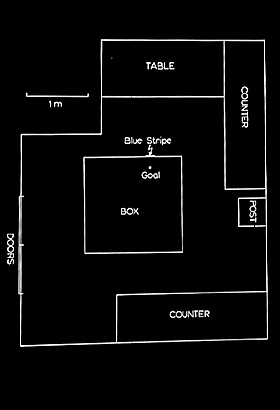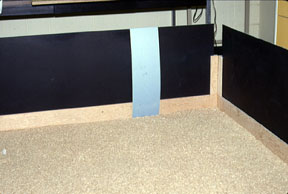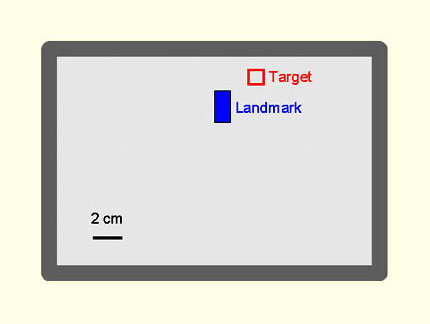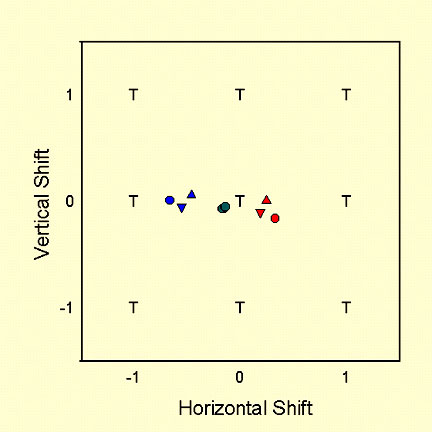Cheng
& Spetch Homepage
Next Section:
Selective
stimulus control
__________
|
III. Pigeons average the dictates of different
landmarks
In searching for a goal, pigeons often follow the dictates of more
than one cue. The dictates of different cues are averaged in guiding searching
behavior. Some examples from studies conducted in open laboratory rooms and touch-screen
monitors are presented below to illustrate this point.
Open Field Tests in
Laboratory Rooms
|
Training Phase

In these tests, the pigeons were trained and tested in a square arena in a lab room (Cheng,
1988).
|

The to-be-shifted landmark, a blue
stripe, is shown
above in its training
position.
|
|
Transformation Test Phase
Performance on Control Tests. The
following shows a video clip from overhead of a
pigeon performing a control test
using the above training setup. The target (food) is usually near where the bird is pecking in the
picture, in front of the blue stripe on the back wall (light grey in the black
and white video). But on this test, there is no reward to be found.
Nevertheless, the bird searches in the right place on such tests. video clip from overhead of a
pigeon performing a control test
using the above training setup. The target (food) is usually near where the bird is pecking in the
picture, in front of the blue stripe on the back wall (light grey in the black
and white video). But on this test, there is no reward to be found.
Nevertheless, the bird searches in the right place on such tests.
|
Performance on Landmark Shift Test.
Following this training, a test was conducted in which the blue stripe has  been shifted 30 cm to the left.
The pigeon's searching also shifts to the left, but not by the full 30
cm, suggesting the pigeon averages the dictates of both shifted and unshifted landmarks.
Click on the picture for a short video clip of the bird's search
during such a test. The markers at the beginning indicate the theoretical target locations according
to the shifted stripe (left) and unshifted landmarks (right). Other experiments on landmark-based search have also found averaging
(e.g., Cheng, 1989). When one landmark is shifted on a test, pigeons often
follow its dictates only part of the way. In fact, pigeons (and humans)
can average quite disparate dimensions of experience. Cheng, Spetch, and
Miceli (1996) found that pigeons and humans averaged the dictates of elapsed
temporal duration with the spatial position of a moving landmark.
been shifted 30 cm to the left.
The pigeon's searching also shifts to the left, but not by the full 30
cm, suggesting the pigeon averages the dictates of both shifted and unshifted landmarks.
Click on the picture for a short video clip of the bird's search
during such a test. The markers at the beginning indicate the theoretical target locations according
to the shifted stripe (left) and unshifted landmarks (right). Other experiments on landmark-based search have also found averaging
(e.g., Cheng, 1989). When one landmark is shifted on a test, pigeons often
follow its dictates only part of the way. In fact, pigeons (and humans)
can average quite disparate dimensions of experience. Cheng, Spetch, and
Miceli (1996) found that pigeons and humans averaged the dictates of elapsed
temporal duration with the spatial position of a moving landmark.
|
|
Experiments with Touchscreens in
Operant Chambers
|
Training Phase

In these experiments, pigeons pecked at a monitor screen in
a computerized operant chamber (Spetch, Cheng,
& Mondloch, 1992). The target location was near the top edge of the screen.
A graphic landmark (rectangle in blue) was near the target. After preliminary training, the
red target was made invisible.
|
|
|
Transformation Test Phase

On subsequently unrewarded tests, this landmark was shifted left
(blue datapoints),
remained where it usually was (green datapoints), or was shifted right
(red datapoints). The extent of the horizontal landmark shifts are indicated by the distance
between two Ts. The results showed that the pigeons shifted their peak place of searching
with the horizontal landmark shifts, but not to the full extent of the
landmark shifts. Thus, they were averaging the dictates of the shifted landmarks and
the rest of the unshifted landmarks. The pattern of results resembles what was found in the search task
in the tests in open-field arena (Cheng, 1988, 1989; Cheng & Sherry, 1992)
|
|
Next Section: Selective
stimulus control
|

